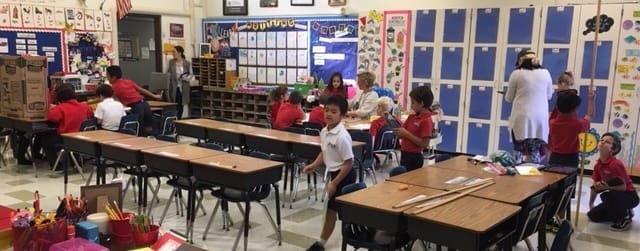Personalizing PD for highly-effective, personalized-learning teachers
February 5, 2019 |
February 5, 2019 |

A blended classroom at St. Bonaventure School. Photo courtesy of Diocese of Orange Catholic Schools.
There is little doubt that technology is a key tool to enable student-centered teaching and learning. After all, it was this premise that led to the great 1:1 race in which schools and districts invested hundreds of thousands, if not millions, of dollars to get devices into the hands of as many students as possible. In their haste to be the first to lay claim to the most modern technology, however, many schools neglected to address the most essential piece of successful classroom learning: a highly effective teacher.
Sustainable success in blended learning starts with teachers
In the Diocese of Orange Catholic Schools, we are committed to developing highly-effective teachers who can provide focused, personalized instruction to help students attain mastery of content. As Beth Thomas, a teacher at St. Junipero Serra School and ABLE Fellow put it, “When high-quality teaching is infused with the dynamic use of technology, personalized student learning becomes possible.”
In the Diocese of Orange, we believe that blended learning is the best instructional approach to reach these goals. Erin Watson, 2nd-grade teacher at St. Catherine School and ABLE Fellow explains why she believes in blended learning. “While I can always improve upon my methodologies, blended- and personalized-learning methodologies have helped me tap into the strengths of each student and create a spark for learning.” However, it cannot be assumed that all teachers know how to effectively implement blended learning as an instructional strategy. According to a recent article on the Christensen Institute’s blog, research has shown that teachers are not receiving training in blended learning in their credentialing courses.
Consequently, the Diocese of Orange has implemented a teacher coaching program to provide personalized professional development to teachers. The program, entitled the ABLE (Advancing Blended Learning Education) Fellowship, was modeled after the FuseRI program in Rhode Island. Exceptionally qualified educators from throughout the diocese are sought to serve as peer coaches. Following a rigorous application process, some of these teachers are selected to become fellows in the ABLE program. Fellows receive intensive training in blended learning and coaching strategies. Each fellow is then assigned to coach 3-4 teachers at another school within the diocese. Fellows communicate with teachers at their partner schools regularly to establish personalized instructional goals aimed at improving blended and personalized instruction, and measure progress toward those goals.
All too often, professional development consists of “one and done” trainings in which there is no follow up. Evidence shows a direct link between student success and teachers that receive mentoring. The ABLE Fellowship provides that missing piece by connecting early adopter teachers to peer coaches who can provide extended support for blended learning.
Danielle Ekno, a new ABLE Fellow, explained, “I was a mentee last year and I was so excited when given the opportunity to mentor other teachers. I am looking forward to all the other wonderful information I will be receiving and sharing with other educators.”
Lessons from revolutionizing teacher PD
Over the past two years, our program has taught us a great deal. Some of the key points are:
There are so many aspects of blended learning, from classroom layout to personalization. It is too difficult to attempt to cover them all. Decide which 2 or 3 specific aspects are most important to your district or school and stick to those during the program’s initial phases.
While administrators do not have to be blended-learning experts, they do need to support the methodology. It is important to include site administrators as partners in the process. Since fellows cannot be at the school every day, be sure that site administrators understand the coach’s goals for their mentees and support those goals on a regular basis between fellow visits. Continuity is imperative to the success of the fellowship.
Regardless how excellent a program,fellows always experience ups and downs throughout the process. Give fellows time to discuss these experiences and possible solutions. Many times another fellow has a solution to a problem.
The relationship between the fellow and mentee should be one of mutual trust and respect. If the mentee does not respect the fellow and his or her abilities as an educator, little will be accomplished. Communication (whether synchronously or asynchronously) must exist beyond the fellow’s site visits. After all, the goal is for the mentee to continue advancing their blended-learning methodology beyond their time with the fellow.
The ABLE Fellowship is currently providing coaching for approximately 30 teachers in 10 schools in the Diocese of Orange. While student success data is only preliminary at this point, early results are very positive where teachers are receiving peer coaching. Check out our video to see more about the ABLE Fellowship or follow us on Twitter at #ABLEOC.
Scott Gotreau is the Director of Educational Technology in the Diocese of Orange in California. Contact him at [email protected] or via Twitter @ScottGotreau.
Leave a Reply